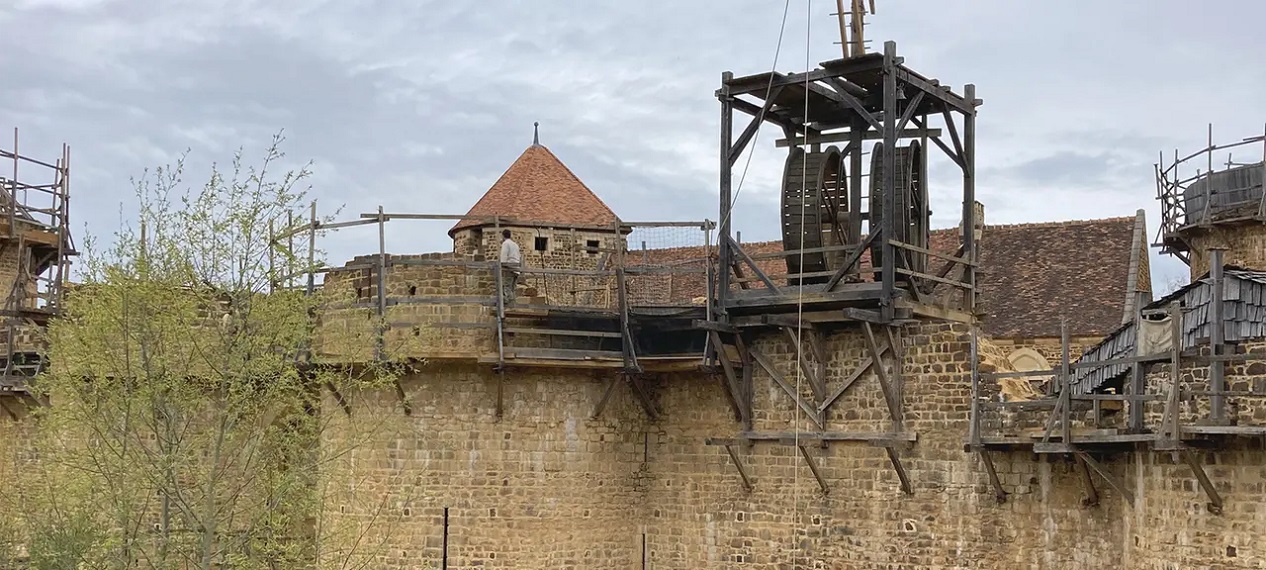Building like in the 13th century
Guedelon: A Medieval Dream Come True
For medieval fans, Guedelon is a magical word. Located in the heart of France, it is the site where a castle is being built using authentic medieval construction techniques, right down to the use of twelve-knot cords instead of modern technology.
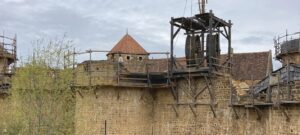
“On this construction site, you are invited to ask anyone questions to understand their craftsmanship. Just say ‘Hello’, most of them won’t bite.”(“You are invited to ask anyone questions to understand their craftsmanship. Just say ‘Good day’, most won’t bite.”) These are the welcoming words of a young man dressed in a Robin Hood outfit, greeting everyone on the covered platform. From there, visitors can marvel at sandstone towers, walls, and battlements. Here, Guilbert, the fictional “Seigneur of Guedelon,” is building his castle with modest resources, following the instructions of his king, Philippe-Auguste.
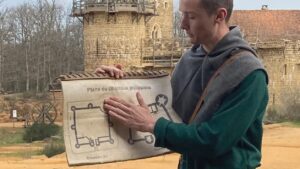
We find ourselves in the 13th century – yet still modern in some ways.”This year, Guedelon has transitioned to zero waste. Plastic on the ground – that wouldn’t be very medieval, and it’s also not good for the planet. So, please throw your trash in the bins provided.”(“This year Guedelon has transitioned to zero waste. Plastics on the ground – that wouldn’t be very medieval or good for the planet. Please dispose of your rubbish in the bins provided”), Guilbert urges.
A Castle Purchase Sparking Many Questions
Michel Guyot founded the Guedelon project in 1997. Now 76 years old, he also owns the nearby Saint-Fargeau Castle. One day, researchers inform him that an even older castle is hidden within. This sparks the idea of building an entirely new castle using only medieval methods, including using a twelve-knot cord to determine right angles. Guyot shares his story in a documentary film:
“In my youth, I helped restore dilapidated castles, bought one with my brother, and then acquired Saint-Fargeau. We asked ourselves: How did they do it 800 years ago? Building a new castle was an absolute dream, a crazy idea. Our vision extends over a century. In the end, this magnificent work might be listed as a heritage site.”
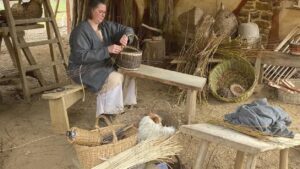
A disused quarry near a stream in an oak forest provides the building materials and earns its place on the map. Guedelon becomes an instant success: The owner anticipated 3,000 visitors in the first year, but 50,000 people came to see a few stones and two huts.
“Working here is pure bliss”
Today, a proper castle stands with a chapel tower and a palace, attracting 300,000 visitors every year. Guedelon now employs around 70 workers, 40 of whom work directly on-site. Under a wooden roof, Camille, wearing protective glasses and a chisel, works on carving a white stone block for an entrance tower. “This is my first time here, and I’ll be staying for two weeks as part of my stone masonry training. Working here is amazing. Pure bliss.”
Clad in a dusty cloak, Loic carries a dark sandstone block with an iron rod. He has been a quarryman in Guedelon for three years and happily whistles as he works. “Look, I found a twelve-ton rock. All it takes is a little digging, and you have such massive chunks. I analyze the stone’s shape, its weak points, and then sculpt it to the right size. It’s fun.”
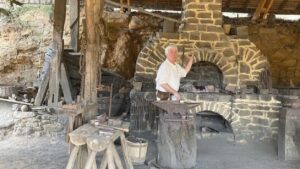
Next to the basket weaver, a bearded ropemaker instructs visitors to crank the handle to twist natural fibers into rope. And Thomas gets messy in the brickyard. “Using clay, sand, and straw, I prepare a mixture that I shape into molds. It dries without being fired. These blocks are for the rural surroundings, not for the castle itself. They will be used as the foundation for the blacksmith’s forge.
Baskets, Chisels, and Shingles
Blacksmith Loic, with white hair and a leather saddlebag at his waist, fans the fire with a bellows. The forge burns with charcoal, the best fuel in the Middle Ages. “I’m here to repair the chisels of the stonemasons. They come to us dull after two to three weeks of use. We heat them up, shape them to a point with a few hammer strikes, file them smooth, and temper them.” A young boy exclaims that it looks like a pencil and asks why the blacksmith isn’t wearing gloves.
A few steps away, Pascale sits atop a wooden stool, wearing a floppy hat. As a carpenter, he has witnessed the castle’s growth since it was three meters high. He has been involved for over 20 years. “This year, we’re making oak shingles for the dovecote’s roof. It takes time because we spend half of our work hours answering questions.”
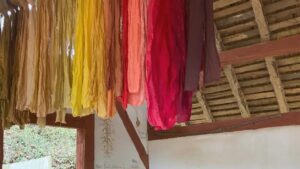
With a final nail and some banter with visitors, Pascale continues, “This is an experimental construction site. We have built things, torn them down because we didn’t know any better. At first, we had square towers. No, said the advisory board. Now we have round ones. But that’s no longer allowed; we’re careful about what we do.”
“Adding charcoal creates a bluish-gray hue”
Dima, a Ukrainian refugee, smooths a wooden plank with an axe. He knows his way around. “The construction site is interesting. I have worked with wood in Ukraine. Here, I’m preparing boards for the grain mill. Every year, something new is added. Soon, the bakery will be built. For pizza? No, for bread!”
Guedelon boasts a garden and livestock. The ramparts invite exploration, as does the interior with its flower frescoes in natural colors. It is Claire, the dyer, who concocts these hues. With a red linen cloth wrapped around her head, she sits in her hut, surrounded by bark containers filled with colored powders. “I can create 15 colors using only the minerals I find around the castle. For example, yellowish or reddish ochre. Lime creates white. Adding charcoal creates a bluish-gray hue.”
Meanwhile, action unfolds at the castle gate. Professional builder Guillaume, secured by a harness but without a helmet, works just below the top of the wall. Scaffold beams are hoisted up using a pedal-powered crane. “We’re not high enough to start placing new stones, so we’re extending the scaffolding. Our helmets are hanging down there on the wall. We need them to protect our heads from falling objects. But above us, there’s nothing, so no risks!”
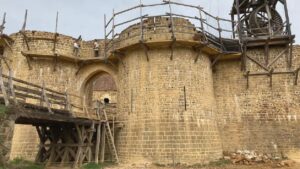
Perhaps pyramids will be added someday too, Guillaume jokes. He knows that at Guedelon, the journey is the destination. “We’re not in a rush to finish. It’s about the act of building itself. A church is planned, maybe even pyramids.” He chuckles. “We prefer to work a little slower each day than the day before. Our work needs to last until our retirement.”
An elderly grandmother asks her grandson, “Do you like it, Leon?” He replies with a yes and asks if he can walk across the small bridge over there. He is allowed. His sister Lisa says, “I like how they worked in the Middle Ages. But it must have been tough!”
Nicolas and Jeremy, who traveled about 400 kilometers, also find it challenging to stack Gothic pointed arch windows using building blocks. They conclude, “It was amazing. Seeing all the medieval construction techniques, arches, and scaffolding. But you really need to be patient to end up with a beautiful castle!”




























